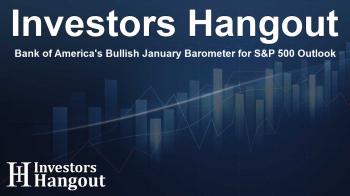Bank of America's Bullish January Barometer for S&P 500 Outlook

Bank of America Forecasts a Bullish Start for S&P 500
According to analysis from Bank of America, the initial performance of the S&P 500 index points to a potentially prosperous year ahead. The January barometer indicates positive momentum, suggesting that a strong beginning can lead to better outcomes for investors.
Understanding the January Barometer
The January barometer is based on historical data, which shows that when the S&P 500, referred to as SPX, experiences a positive trend in its first five trading sessions, it typically bodes well for the remainder of the year. With a recent rise of 0.62%, this initial performance aligns with historical precedents dating back to 1928, where positive returns often follow such a start.
The Numbers Speak Volumes
Bank of America noted, “When the first five sessions of the year are up, the year is up 70% of the time with an average return of 9.2%.” The predictions for 2025 are particularly promising, as the average returns tend to be even higher during the first year of a presidential cycle.
Presidential Cycle Performance
In presidential election years, if the index rallies during its initial five sessions, historical data shows the SPX is likely to close the year up 79% of the time. Investors can anticipate an average annual gain of around 12.5% under these conditions, making this information particularly appealing to market watchers.
Market Dynamics and Volatility
Despite the optimistic outlook, BofA’s analysts also cautioned about the inherent volatility associated with the stock market's behavior at the start of the year. The SPX has been navigating through the technical challenges following significant political events, such as the 2024 Presidential election.
Technical Analysis Insights
Strategist Stephen Suttmeier highlighted potential technical challenges, suggesting that the SPX is contending with a head and shoulders top formation. This pattern could impose a market overhang unless the index surpasses critical resistance levels between 6017 and 6050. Furthermore, if the SPX drops below certain key levels, it could face heightened selling pressure.
Support Levels and Market Sentiment
As the S&P 500 finds its footing, the 5700-5650 range serves as a crucial support area. The index's recent move below its daily Ichimoku cloud span reveals potential resistance that could impede growth, with the range between 5886 and 5965 acting as a challenging barrier to overcome.
Investor Sentiment Analysis
Presently, sentiment indicators indicate a shift towards bearishness, with the spread between bullish and bearish sentiments at its lowest since late 2023. Despite these fluctuations, it’s essential to recognize that current sentiment levels may not definitively signal a market bottom.
Understanding VIX Levels
Examining the volatility index (VIX) offers further insight into market conditions. Although the 30-month VIX relative to the market has seen a decline, it has yet to reach the oversold threshold. This lack of extreme conditions suggests that the market may not be priced for a significant downturn just yet.
Risks to Consider Moving Forward
The analysis by BofA also brought attention to a bearish divergence observed in the 14-week Relative Strength Index (RSI). This divergence highlights a potential risk factor for the market in 2025, as the weakening monthly RSI trend indicates that although SPX rallied, it hasn't achieved overbought status during recent all-time highs.
Frequently Asked Questions
What is the significance of the January barometer?
The January barometer is a predictive tool indicating that a positive start in January often leads to favorable market performance for the rest of the year.
How reliable is the historical data for the S&P 500?
Historical trends suggest strong correlations where a positive January coincides with remarkable returns throughout the year, bolstered by extensive data analysis.
What factors could impact the S&P 500 in 2025?
Market volatility, sentiment shifts, and technical patterns may all play significant roles in shaping the index's performance throughout the year.
How does the presidential cycle affect stock performance?
The initial performance of stock markets tends to be more robust in the first year of a presidential cycle, with historical data pointing to higher success rates.
What is the outlook for investors this year?
While the outlook appears promising based on the January performance, investors should remain mindful of potential volatility and sentiment shifts that may influence market dynamics.
About Investors Hangout
Investors Hangout is a leading online stock forum for financial discussion and learning, offering a wide range of free tools and resources. It draws in traders of all levels, who exchange market knowledge, investigate trading tactics, and keep an eye on industry developments in real time. Featuring financial articles, stock message boards, quotes, charts, company profiles, and live news updates. Through cooperative learning and a wealth of informational resources, it helps users from novices creating their first portfolios to experts honing their techniques. Join Investors Hangout today: https://investorshangout.com/
Disclaimer: The content of this article is solely for general informational purposes only; it does not represent legal, financial, or investment advice. Investors Hangout does not offer financial advice; the author is not a licensed financial advisor. Consult a qualified advisor before making any financial or investment decisions based on this article. The author's interpretation of publicly available data presented here; as a result, they should not be taken as advice to purchase, sell, or hold any securities mentioned or any other investments. If any of the material offered here is inaccurate, please contact us for corrections.
